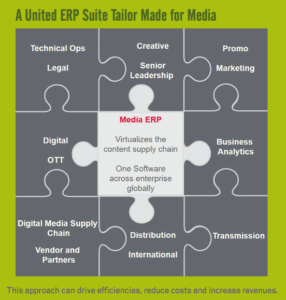HITS

M&E Journal: Changing Consumer Demands and the Agility Needed to Support Them
Story Highlights
By T Shobhana, VP Head, Global Marketing & Communications, Prime Focus Technologies
Today’s consumer is an evolved creature and already “cord-cutters” have become old news among young adults. In deserting the traditional model of television for a variety of digital outlets that provide the convenience of consumption when they want it, the way they want it, the newest consumers–the so-called “cord-nevers”–are increasing demands on an industry that finds itself woefully outdated.
Increasing volume of content, ease in discovery, multiple platforms and devices, need for speed, monetization components and making everything digital are all daily challenges for content providers that need to be factored in to the content creation process.
The M&E industry is changing at an ever increasing pace, and many content enterprises are struggling to keep up.
Growing numbers of digital outlets globally have acutely driven the need for content owners to embrace the cloud, not only to service the required volume and speed of content delivery, but to capture the attention of fickle digital consumers that have myriad content options available at their fingertips. With 800 million iTunes users, 75 million subscribers on Netflix, six billion hours of video watched per month on YouTube, and 19 percent of U.S. millennials using Amazon Prime, content owners are in a mad race to get content to digital platforms faster, cheaper and to make it quickly discoverable.
Outdated systems and independent media asset management (MAM) services used by the M&E industry have led to delivery delays, rampant content duplication and incremental costs, resulting in an inefficient enterprise. Traditional organizational structures, inefficient older IT systems, duplication of staff skills, higher costs and a lack of scalability in the changing world of the digital consumer remain embedded within the content enterprise.
A single, enterprise-wide solution that embraces technology for business transformation beyond technical departments is the solution to these challenges. A united, enterprise resource planning (ERP) suite tailor made for media, such as Prime Focus Technologies’ CLEAR, is proven to drive efficiencies, reduce costs, enhance creativity and increase revenues.
Keeping up and controlling costs
In a connected world, having the content at the center of the businesses with software to manage it and workflows around it, across the content life cycle, will emerge as a necessity. In the process, an end-to-end digital solution will not only reduce unused and duplicate media asset costs but assist in generating additional revenues through lead-time reduction of new service offerings.
A fully equipped ERP suite can maximize operational efficiencies and allow for workflow orchestration across enterprise, supply chain and partner ecosystems. Preset robots can smartly prepare, package and deliver content to both linear and non-linear platforms, automating what before was a manual process. Along with detailed, multi-layer smart metadata, content owners are able to deliver large volumes of content quickly, while creating an easily discoverable and engaging experience for the consumer.
 Equally as important as the need to deliver content quickly and effectively is the need to do so with lowest total cost of operation. Broadcasting revenues are expected to remain flat over the next five years while operating costs are expected to rise at a faster pace due to a proliferation of screens.
Equally as important as the need to deliver content quickly and effectively is the need to do so with lowest total cost of operation. Broadcasting revenues are expected to remain flat over the next five years while operating costs are expected to rise at a faster pace due to a proliferation of screens.
Content owners need to drastically and quickly realign operating strategies to succeed in the “new normal” of multi-platform and digital consumers.
By virtualizing content supply chain operations, freeing up human bandwidth and maximizing operational efficiencies, an effective ERP solution can bring in savings in operating costs to the tune of millions of dollars while implementing an effective business process management across the enterprise, enabling monetization and adding new revenue streams.
Understandably, many content enterprises may be hesitant to overhaul legacy systems for fear of associated costs. What cloud and software-as-a-service solutions can offer is the ability to scale operations at a level of comfort, allowing enterprises to grow appropriately and pay accordingly for lowest cost of ownership. Regardless, content owners can no longer afford to ignore the model completely and must look to change the way they do business.
Another often cited concern over moving to a cloud-based solution is security. In the age of digital piracy, content isn’t king, it’s the entire kingdom and many content enterprises are wary of entrusting such valuable assets to off-premise storage. Hybrid cloud solutions offer the perfect middle path, addressing the anxiety and concerns owners have towards allowing critical IP content to rest entirely outside the business premises. It offers a fine balance between on-premise storage and off-premise archiving.
In addition to the already notable benefits of reduced operational costs and enhanced efficiencies, adopting a single ERP system to manage the business of content can have far reaching benefits to an enterprise.
By virtualizing the time consuming processes of user rights and licenses to storage subscriptions and more, an ERP solution provides more business agility and contributes to net new revenue by allowing creators to focus their efforts towards making better content, rather than the business behind managing it.
The mobile and connected nature of a cloud-based system fosters collaboration between departments, further enhancing creativity and enabling users to access their content from anywhere, anytime on any device, with utmost security.
Departments across the globe can all access content, make notes and provide feedback at a moment’s notice. This also serves to liberate creative teams, offering them a work-life balance that cannot be achieved with disparate, on-premise, legacy systems.
By adopting a one software ERP system, media and entertainment enterprises, from studios to broadcasters to post production houses and more, can adapt to the changing of times, connect with today’s digital consumer and facilitate development of the best possible content.
Click here to translate this article
Click here to download the complete .PDF version of this article
Click here to download the entire Spring 2016 M&E Journal









